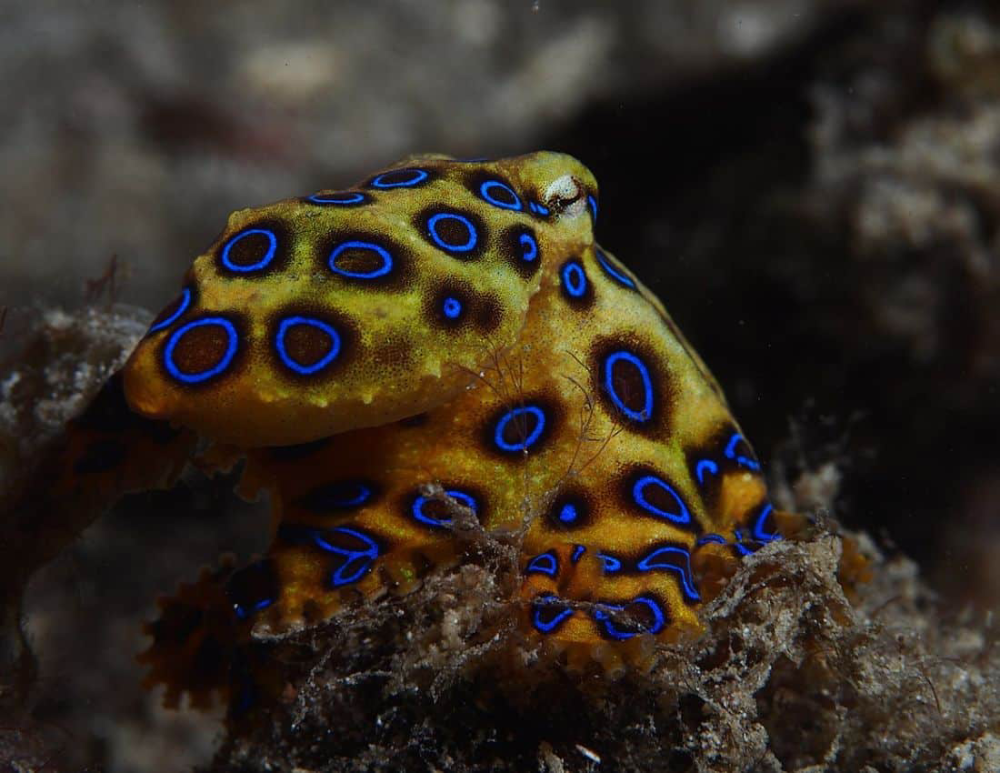In the underwater realms of the Indo-Pacific, a creature of mesmerizing beauty and lethal potency lurks in the shadows—the Blue-Ringed Octopus. Despite its diminutive size and delicate appearance, this enigmatic cephalopod harbors one of nature’s most potent venoms, rendering it a fascinating subject of both intrigue and caution. Let us embark on a journey into the world of the Blue-Ringed Octopus, exploring its biology, behavior, and the peril it presents to those who encounter it.
The Elegance of the Blue-Ringed Octopus
Measuring no larger than a golf ball, the Blue-Ringed Octopus (genus Hapalochlaena) possesses a captivating allure. Its typically yellowish-beige body, adorned with vivid blue rings outlined in black, creates a striking contrast against the sandy seabed where it often resides. However, these vibrant hues serve as a warning—a visual proclamation of the potent neurotoxin coursing through its veins.
Biology and Habitat
Belonging to the family Octopodidae, the Blue-Ringed Octopus comprises several species, each with its unique distribution across the Indo-Pacific region. From the shores of Japan to the reefs of Australia, these cephalopods inhabit shallow coastal waters, often concealed amidst crevices or nestled within coral formations. Despite their preference for concealed habitats, they occasionally venture into more open waters during nocturnal hunting expeditions.
Unlike their larger relatives, such as the Giant Pacific Octopus, Blue-Ringed Octopuses boast a compact physique, with an average arm span of merely 12 to 20 centimeters. Their diminutive size facilitates maneuverability through intricate coral structures and enhances their ability to ambush prey with swift precision.

Behavior and Predation
Blue-Ringed Octopuses are predominantly solitary creatures, emerging from their hiding places under the cover of darkness to hunt crustaceans, small fish, and mollusks. Utilizing their keen eyesight and adept camouflage skills, they patiently stalk unsuspecting prey before launching a lightning-fast ambush. Their arsenal includes not only venom but also a remarkable intelligence, allowing them to outsmart prey and evade potential predators.
The Lethal Venom
Perhaps the most notorious aspect of the Blue-Ringed Octopus is its venom—a potent cocktail of neurotoxins capable of inducing paralysis and respiratory failure within minutes. Despite its lethal potency, the octopus does not actively seek out confrontation with humans, preferring to employ its venom exclusively for subduing prey and defending against perceived threats.
The neurotoxin responsible for the octopus’s venom is known as tetrodotoxin, a compound also found in pufferfish and certain other marine organisms. Tetrodotoxin effectively blocks sodium channels in nerve cells, leading to paralysis and ultimately respiratory arrest in severe cases. Despite its deadly nature, tetrodotoxin also holds promise in medical research, particularly in the development of pain-relief medications and treatments for neurological disorders.
Encounters with Humans
While encounters between Blue-Ringed Octopuses and humans are relatively rare, they pose a significant risk due to the potency of their venom. Inadvertent disturbance or provocation may prompt the octopus to display its namesake blue rings as a warning signal, signaling its readiness to defend itself if necessary. However, due to their small size and cryptic nature, these octopuses may go unnoticed until it is too late, making awareness and caution paramount in coastal regions where they are known to inhabit.
Conservation Status and Future Outlook
Despite their allure and ecological significance, Blue-Ringed Octopuses face various threats, including habitat degradation, overfishing, and pollution. As keystone predators within their respective ecosystems, their decline could have cascading effects on marine biodiversity. Efforts to conserve these enigmatic creatures require a multifaceted approach, encompassing habitat protection, sustainable fisheries management, and public education regarding the risks they pose and the importance of preserving their habitats.
Conclusion
In the depths of the Indo-Pacific, the Blue-Ringed Octopus reigns as a testament to nature’s beauty and complexity. From its bewitching appearance to its lethal venom, this diminutive cephalopod captivates the imagination while commanding respect and caution. As stewards of the oceans, it is our responsibility to safeguard the habitats that sustain these mesmerizing creatures, ensuring that future generations may continue to marvel at their splendor from a safe distance.









